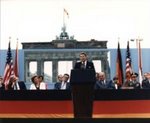As I posted earlier, I am reading a book by H.W. Brands about FDR. It has really added to my knowledge about the years leading up to WWII. FDR was restrained by a series of legislation collectively called the Neutrality Act first signed in 1935 and later amended. This act was a piece of legislation that prohibited several actions by the government that had led to the first World War such as the unrestricted submarine warfare against American shipping that was transporting supplies to the allies in that war, France and Britain. The Germans had been using the U-Boat fleet to sink as much of that shipping as they could. Eventually these actions brought a declaration of war by the U.S. on Germany in April 1917.
After the first World War a strong isolationist movement grew in the country throughout the 1920s and 1930s culminating in this neutrality legislation. As Europe became more unsettled through the 1930s and it was apparent that a war was coming, F.D.R., through a series of communications with Churchill expressed a desire to assist the British once war broke out in September 1939. However, he was blocked by the legislation and the vehement opposition of the very strong isolationists in the country.
I found it interesting that following a meeting that produced a document later called the Atlantic Charter, Churchill was later quoted as saying that FDR had laid out a strategy that would bring America into the war. Churchill stated that "He (FDR) would wage war, but not declare it." "He would become more and more provocative...Everything was to done to force an 'incident'...he would look for an 'incident' which would justify him in opening hostilities." (Page 609) Roosevelt denied it, but all his actions leading to American entry in the war are convincing that he in fact was willing to take these measures to ensure the country's entry into the war. Lend-Lease was certainly a creative way to avoid the Neutrality Acts.
A U.S. warship, the Greer, was fired upon by the Germans while it was assisting in a British operation against U-Boats in the Atlantic. FDR stated the ship was carrying the mail and flying the American flag. All true but he failed to mention the assistance it was providing to the British. It is interesting that FDR was willing to use American service men in this manner, don't you think? My guess is it was in his mind a necessary risk to defeat Hitler. FDR made much of this incident in an attempt to maximize the public pressure on the isolationists and rally public opinion against them. As we all know, Pearl Harbor later that year ended any discussion about America's entry into the war.
FDR's obfuscation has historic precedence. The sinking of the Maine in 1898 prior to the Spanish-American War. The posting of troops into the disputed territory north of the Rio Grande before the Mexican-American War in 1846. The Gulf of Tonkin incidents in 1964 that resulted in the Gulf of Tonkin Resolution and the later escalation in Vietnam. All were questionable but integral to resultant wars.
This verifies some information I had read previously that questioned FDR's actions prior to Pearl Harbor. I, by no means, question America's entry into WWII but I certainly think this information is good fodder for a look at FDR and his pre-war campaign to involve America in the war.
Tuesday, April 9, 2013
Subscribe to:
Post Comments (Atom)










2 comments:
I've always felt he did a masterful job of delaying our entry until the other major world economies had punched themselves out and we would be the last economy standing.
20 million Russians took the brunt and we don't even know it in America.
Ducky,
I would like to think he thought that but I think he thought about his politics more than anything. In his 1940 race he was able to deflect the third term problem with his rhetoric about the European war. This safely put Wilkie on the defensive and neutralized the isolationists.
Thanks for stopping by.
Post a Comment